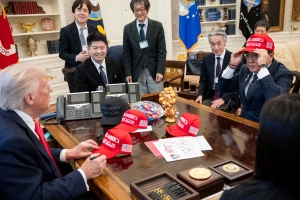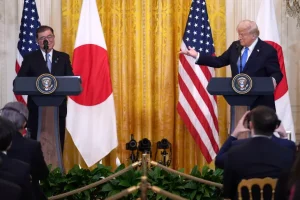Washington D.C. – President Donald Trump announced a groundbreaking Trump Deal With Japan on Wednesday, describing it as the “largest deal ever made” between the two nations. The Trump Deal With Japan encompasses a massive $550 billion investment commitment from Japan into the United States, representing one of the most significant international trade agreements in recent history.
The Trump Deal With Japan announcement was made through Trump’s Truth Social platform, where he outlined the comprehensive nature of the agreement and its potential impact on American employment. According to the President’s statement, this Trump Deal With Japan will create hundreds of thousands of jobs across the United States, marking an unprecedented economic partnership between the two allied nations.
The timing of the Trump Deal With Japan comes amid ongoing discussions about international trade relationships and America’s economic positioning in the global marketplace. This agreement represents a significant diplomatic and economic achievement for the Trump administration’s approach to bilateral trade negotiations.
Financial Structure and Investment Details

Under the terms of the Trump Deal With Japan, the United States is positioned to receive 90 percent of the profits generated from this historic partnership. The Trump Deal With Japan structure indicates that Japan will invest the substantial $550 billion sum under Trump’s direct guidance and strategic direction.
President Trump emphasized that the Trump Deal With Japan represents an investment made at his personal direction, highlighting the hands-on approach taken in negotiating this significant international agreement. The profit-sharing arrangement within the Trump Deal With Japan heavily favors American interests while maintaining a cooperative framework with Japan.
Also Read: Hong Kong To Delhi Air India Flight Catches Fire After Landing – 140 Passengers Safe
The financial implications of the Trump Deal With Japan extend far beyond the initial investment amount, as the agreement is designed to generate sustained economic benefits for American workers and businesses over the long term. This investment structure demonstrates the administration’s commitment to securing advantageous trade terms for the United States.
Tariff Implementation and Trade Policy
Alongside announcing the Trump Deal With Japan, President Trump confirmed the implementation of 15 percent tariffs on imports from Japan. These tariffs represent a key component of the Trump Deal With Japan strategy, balancing investment incentives with protective trade measures for American industries.
The 15 percent tariff rate associated with the Trump Deal With Japan reflects a measured approach to trade policy that seeks to protect domestic manufacturing while maintaining productive economic relationships. This tariff structure within the Trump Deal With Japan framework aims to level the playing field for American businesses competing with Japanese imports.
Trump’s announcement regarding tariffs as part of the Trump Deal With Japan demonstrates the administration’s commitment to using trade policy as a tool for promoting American economic interests. The tariff component ensures that the benefits of increased Japanese investment are balanced with protection for domestic producers.
Sector-Specific Trade Openings
This Deal With Japan includes significant provisions for opening Japanese markets to American automotive and agricultural exports. Under this agreement, Japan will increase access for American cars, trucks, rice, and various other agricultural products, representing substantial new opportunities for American exporters.
The automotive provisions within the Trump Deal With Japan are particularly significant given the historical importance of this sector in US-Japan trade relations. The agreement promises to create new pathways for American vehicle manufacturers to access Japanese consumers and expand their market presence.
Agricultural components of the this deal With Japan address longstanding American concerns about market access for farm products. The inclusion of rice and other agricultural commodities in the Trump Deal With Japan represents a victory for American farmers who have sought greater access to Japanese markets.
Energy Partnership and LNG Ventures


A crucial element of the Trump Deal With Japan involves establishing joint ventures for liquefied natural gas operations in Alaska. This energy partnership represents a strategic component of the broader Trump Deal With Japan framework, leveraging American energy resources for mutual benefit.
The LNG joint venture aspect of the this Deal With Japan positions both nations to benefit from America’s abundant natural gas resources while strengthening energy security partnerships. This collaboration demonstrates how this Deal With Japan extends beyond traditional trade to encompass strategic resource development.
Political Context and Timing


The Trump Deal With Japan announcement follows closely after Trump’s separate trade agreement with the Philippines, demonstrating active engagement in Pacific region trade negotiations. This Deal With Japan represents a cornerstone achievement in the administration’s broader Asia-Pacific economic strategy.
The timing of the this Deal With Japan coincides with internal political challenges facing Japanese Prime Minister Shigeru Ishiba, who is contemplating his political future amid domestic opposition. Despite these political uncertainties in Japan, the Deal With Japan moves forward as a testament to the enduring economic partnership between the nations.
President Trump characterized this period as “very exciting” for America, emphasizing that this Deal With Japan will maintain and strengthen the historically positive relationship between the two countries while delivering unprecedented economic benefits for American workers and businesses.

